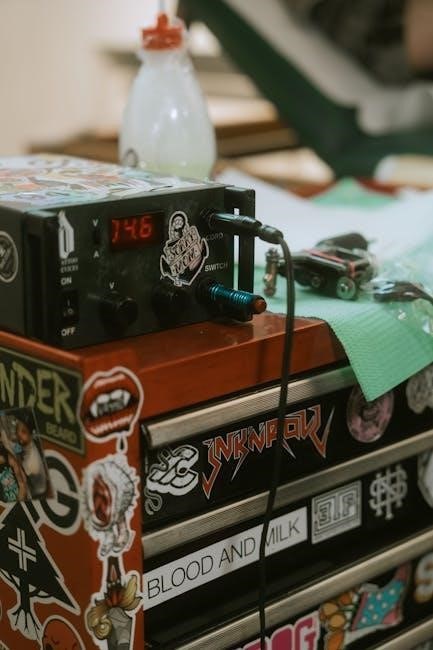Understanding speaker wire gauge is crucial for optimal audio performance. Lower gauges (thicker wires) reduce resistance, ensuring better current flow and sound quality, especially for longer runs.
Speaker wire gauge refers to the thickness of the wire, measured using the American Wire Gauge (AWG) system. A lower gauge number indicates a thicker wire, which offers less resistance and better current flow. This is critical for delivering high-quality audio signals from amplifiers to speakers. The gauge of the wire directly impacts sound quality, especially over longer distances. Understanding the relationship between wire thickness, resistance, and current flow is essential for selecting the right gauge for your system. Properly matching the wire gauge to your setup ensures optimal performance, minimizing signal loss and distortion. This guide explores the fundamentals and practical applications of speaker wire gauge.
Why Speaker Wire Gauge Matters
Speaker wire gauge plays a critical role in ensuring high-quality audio reproduction. Thicker wires (lower gauges) reduce resistance, allowing more current to flow and maintaining signal integrity. Higher gauges (thinner wires) increase resistance, potentially degrading sound quality, especially over longer distances or with lower impedance systems. Proper gauge selection prevents power loss, distortion, and voltage drop, ensuring your amplifier’s full potential is delivered to the speakers. This directly impacts bass response, clarity, and overall listening experience. Choosing the right gauge is essential for optimal system performance and user satisfaction, making it a fundamental consideration in any audio setup.
Understanding American Wire Gauge (AWG)
The American Wire Gauge (AWG) system determines wire thickness, with lower numbers indicating thicker wires. For example, 12 AWG is thicker than 18 AWG. Thicker wires have less resistance, making them ideal for longer runs or systems with lower impedance. AWG is crucial for matching wire size to your system’s needs, ensuring minimal signal loss and optimal performance; Understanding AWG helps in selecting the right wire for your setup, balancing factors like power handling, distance, and resistance to maintain high-quality sound reproduction. Correct gauge selection ensures efficient current flow and reliable audio delivery, avoiding potential issues like voltage drop or overheating.
Common Speaker Wire Gauges
Speaker wire gauges range from 12 AWG to 18 AWG, with 12 AWG being the thickest and 18 AWG the thinnest. These gauges balance resistance, current flow, and system requirements for optimal audio performance.
12 AWG Speaker Wire
12 AWG (American Wire Gauge) speaker wire is the thickest commonly used option, offering the least resistance and highest current capacity. Ideal for high-power audio systems, long wire runs (over 50 feet), and low-impedance speakers, it ensures minimal signal loss and optimal sound quality. Its durability and performance make it a popular choice for car audio setups and home theaters. While bulkier than smaller gauges, 12 AWG wire strikes a balance between performance and practicality, delivering reliable connections for demanding audio applications.
14 AWG Speaker Wire
14 AWG (American Wire Gauge) speaker wire is a versatile option, balancing thickness and flexibility. It is suitable for most home audio systems with moderate power requirements. This gauge is ideal for runs up to 50 feet, offering minimal resistance and signal loss. It works well with 4-ohm or 8-ohm speakers and handles average power outputs effectively. 14 AWG is a common choice for its durability and performance, making it a reliable option for various audio setups without the bulk of thicker wires. Its mid-range size ensures both quality and practicality for everyday use.
16 AWG Speaker Wire
16 AWG (American Wire Gauge) speaker wire is a popular choice for many audio systems. It offers a good balance between thickness and flexibility, making it suitable for installations where space and manageability are important. This gauge is ideal for shorter runs, typically up to 30 feet, and works well with 4-ohm or 8-ohm speakers. Its thinner profile makes it easier to route and install compared to thicker wires like 12 or 14 AWG. While it may not handle high-power systems as effectively, 16 AWG is a reliable option for average home audio setups, providing decent sound quality and durability. It’s also a cost-effective solution for those who don’t need the premium performance of thicker wires.
18 AWG Speaker Wire
18 AWG speaker wire is the thinnest commonly used gauge, offering the least resistance among thinner wires. It’s lightweight and highly flexible, making it ideal for short-distance installations, typically under 20 feet. This gauge is best suited for low-power systems or applications where minimal signal loss is acceptable. While it reduces bulk and cost, it may not handle high-current demands effectively, making it less suitable for high-performance setups. However, for small-scale audio systems or DIY projects, 18 AWG provides a practical and efficient solution, balancing affordability with adequate performance for its intended use cases.
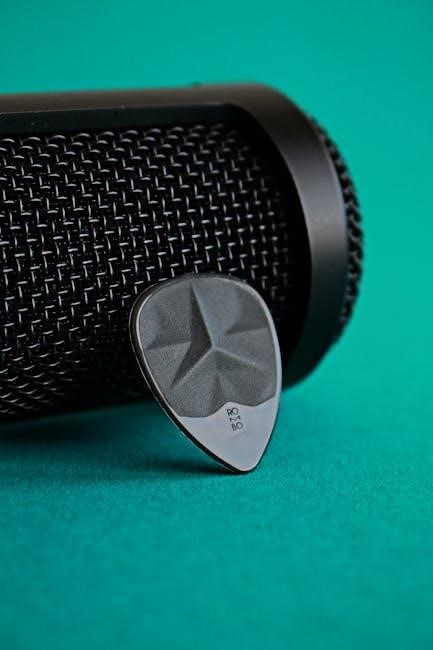
Factors Determining Speaker Wire Gauge
Speaker impedance, power handling, and distance between components are key factors. Lower impedance requires thicker wires, while longer runs demand larger gauges to minimize signal loss and ensure optimal performance.
Speaker Impedance and Its Impact
Speaker impedance plays a significant role in determining the appropriate wire gauge. Lower impedance, typically 4 ohms, requires thicker wires to handle higher current flow, ensuring minimal resistance and optimal audio quality. Higher impedance systems, such as 8 ohms, are less demanding but still benefit from adequate wire sizing. Incorrect gauge selection can lead to power loss, overheating, or distorted sound. Matching the wire gauge to the speaker’s impedance ensures efficient energy transfer and preserves sound fidelity. Proper impedance management is essential for maintaining system performance and longevity.
Power Handling Requirements
Power handling requirements directly influence the choice of speaker wire gauge. Systems with higher power demands necessitate thicker wires to prevent overheating and resistive energy loss. Thicker wires (lower AWG) can handle more current without degradation, ensuring efficient power transfer from the amplifier to the speakers. Insufficient gauge can result in signal loss, overheating, or even fire hazards. Always select a wire gauge that aligns with your system’s power output and speaker demands to maintain optimal performance and safety. Proper matching ensures reliable operation and preserves sound quality across the entire frequency range.
Distance Between Components
The distance between your amplifier and speakers significantly impacts speaker wire gauge selection. Longer runs increase resistance, potentially leading to signal loss and reduced sound quality. For distances exceeding 50 feet, a thicker wire (lower AWG) is recommended to minimize resistance and ensure optimal signal transfer. Thicker wires handle longer runs more efficiently, preserving audio fidelity and maintaining system performance. Always consider the total length of your speaker wire when choosing the appropriate gauge to avoid excessive resistance and ensure reliable operation over the desired distance.
System Performance Needs
Your system’s performance requirements play a key role in selecting the right speaker wire gauge. The wire must handle the power and current your system demands without compromising sound quality. A lower AWG (thicker wire) is ideal for high-power systems to minimize resistance and ensure clear audio reproduction. For smaller systems with lower power needs, a higher AWG (thinner wire) may suffice. Balancing the wire gauge with your system’s specifications ensures optimal performance, preventing signal degradation and maintaining fidelity. Properly matching the wire to your system’s needs guarantees reliable operation and high-quality sound output for an enhanced listening experience.
How to Choose the Right Speaker Wire Gauge
Assess your system’s power handling, impedance, and distance requirements. Match the wire gauge to these needs to ensure optimal sound quality and reliable performance.
Calculating Impedance for Your System
Impedance is a critical factor in determining the right speaker wire gauge. Calculate your system’s impedance by considering the speakers’ ohm rating and the amplifier’s output. Use the formula: impedance (Ω) = voltage (V) / current (I). Lower impedance (e.g., 4Ω) requires thicker wires to handle higher current flow. Higher impedance (e.g., 8Ω) is less demanding but still benefits from proper gauge selection. Match the wire gauge to your system’s impedance to minimize resistance and ensure efficient power transfer. Use online impedance calculators or consult your equipment’s specifications for accurate measurements. Proper calculation ensures optimal sound quality and system performance.
Considering the Length of Your Runs
The length of your speaker wire runs significantly impacts gauge selection. Longer runs require thicker wires to minimize resistance and signal loss. For runs over 50 feet, a thicker gauge (e.g., 12 AWG) is recommended to ensure optimal performance. Shorter runs (under 50 feet) can use thinner gauges (e.g., 16 AWG) without compromising sound quality. Always consider the total distance between components when selecting wire. Longer wires increase resistance, potentially degrading audio signals. Match the wire gauge to the run length to maintain clarity and power delivery, ensuring your system performs at its best.
Matching Wire Gauge to Amplifier Power
Matching the wire gauge to your amplifier’s power output is essential for optimal performance. Thicker wires (lower AWG) can handle higher current, making them ideal for powerful systems. If the amplifier delivers high wattage, a lower gauge wire is necessary to prevent overheating and ensure efficient power transfer. Conversely, thinner wires (higher AWG) are suitable for lower-power systems. Properly matching the wire gauge to your amplifier’s capabilities ensures minimal resistance, maintaining sound quality and system reliability. Always consider the amplifier’s maximum output when selecting wire to avoid potential damage or signal degradation.
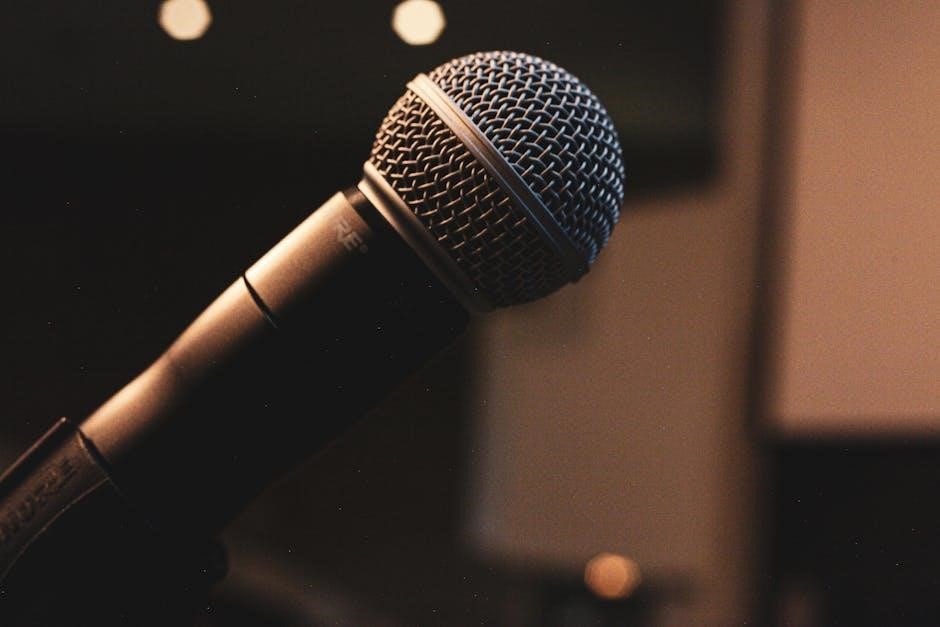
Thicker vs. Thinner Speaker Wires
Thicker wires (lower AWG) reduce resistance, ideal for high-power systems and long runs, while thinner wires (higher AWG) suit shorter distances and smaller setups efficiently.
Pros and Cons of Thicker Wires
Thicker wires, such as 12 or 10 AWG, offer reduced resistance, ensuring better current flow and minimal signal loss, ideal for high-power systems and long runs. They handle more current, reducing heat buildup and maintaining sound quality over distance. However, thicker wires are bulkier, harder to install, and more expensive. They may also be unnecessary for smaller systems, where thinner wires suffice, leading to potential overinvestment. Despite this, their durability and performance make them a reliable choice for demanding audio setups.
Pros and Cons of Thinner Wires
Thinner wires, such as 16 or 18 AWG, are lighter, more flexible, and easier to install, making them ideal for shorter runs and simpler setups. They are also more affordable and widely available. However, thinner wires have higher resistance, which can lead to signal loss and reduced sound quality over longer distances. Additionally, they may not handle high power levels as effectively, potentially limiting their use in more demanding audio systems. Despite these drawbacks, thinner wires are a practical choice for low-power applications and smaller-scale installations where their convenience and cost-effectiveness shine.
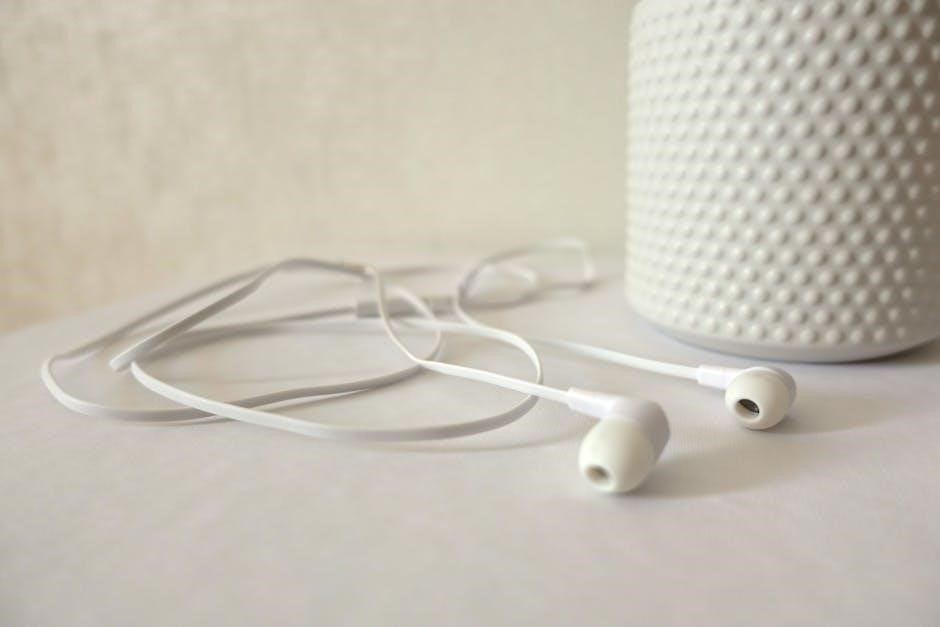
Resistance and Its Impact on Sound Quality
Resistance in speaker wires affects sound quality by causing signal loss, especially over long runs. Thicker wires reduce resistance, ensuring clearer audio and better system performance.
How Wire Resistance Affects Audio Signals
Wire resistance impacts audio signals by causing signal loss and voltage drop, particularly over long distances. Thicker wires (lower gauge) reduce resistance, ensuring more current reaches the speakers. Higher resistance in thinner wires can degrade sound quality, leading to weaker bass and distorted highs; This effect worsens with longer runs, as resistance compounds, reducing the overall power delivered to the speakers. Proper gauge selection minimizes resistance, preserving audio fidelity and ensuring the full dynamic range of the music is maintained. Lower gauge wires are especially critical for high-power systems or installations requiring longer cable runs.
Minimizing Resistance for Optimal Sound
To minimize resistance, choose a speaker wire gauge suitable for your system’s power and distance requirements. Thicker wires (lower AWG) reduce resistance, ensuring less signal loss. Shorter runs also help, as resistance increases with length. Use high-quality materials, like pure copper, for better conductivity. Properly secure connections to avoid added resistance from poor contacts. Additionally, match impedance levels between components to maintain efficiency. Avoid undersizing wires, as this can lead to excessive resistance and degraded sound quality. By optimizing wire gauge and installation practices, you ensure maximum signal integrity and optimal audio performance for your setup.
Safety Considerations
Ensure speaker wires handle maximum current and voltage safely. Use materials rated for operating temperatures and proper installation practices to prevent hazards and maintain reliable performance always.
Maximum Current and Voltage Handling
Speaker wires must handle maximum current and voltage safely to prevent overheating or damage. Choose wires with current ratings that match your system’s power requirements to ensure reliable performance. Lower AWG wires can handle higher current, making them suitable for high-power setups. Always consider the amplifier’s output and speaker impedance when selecting wire gauge to avoid exceeding current limits. Proper matching ensures safe operation and optimal sound quality, while preventing potential hazards like wire degradation or electrical issues over time. This balance is essential for maintaining both system performance and user safety in any audio installation.
Operating Temperature Ranges
Speaker wire performance is influenced by operating temperature ranges, as extreme heat or cold can degrade insulation and conductivity. Most speaker wires are designed to function optimally in standard environments, typically between 32°F and 140°F (0°C to 60°C); Higher-quality wires may withstand broader temperature ranges, ensuring reliability in harsh conditions. Excessive heat can lead to insulation melting or wire degradation, while extreme cold may increase resistance. Always select wires rated for your system’s expected operating conditions to maintain sound quality and longevity. Proper installation in well-ventilated areas can also help manage temperature-related issues, preserving system performance over time.
Installation Best Practices
Proper installation of speaker wires ensures optimal performance and safety. Plan the layout to minimize wire length and avoid interference. Use appropriate wire gauges based on power requirements and distance. Secure wires neatly, avoiding heat sources and tight bends. Apply high-quality connectors for reliable connections. Test the system post-installation to ensure clarity and balance in sound. Always follow safety guidelines to prevent electrical hazards and ensure long-lasting performance.
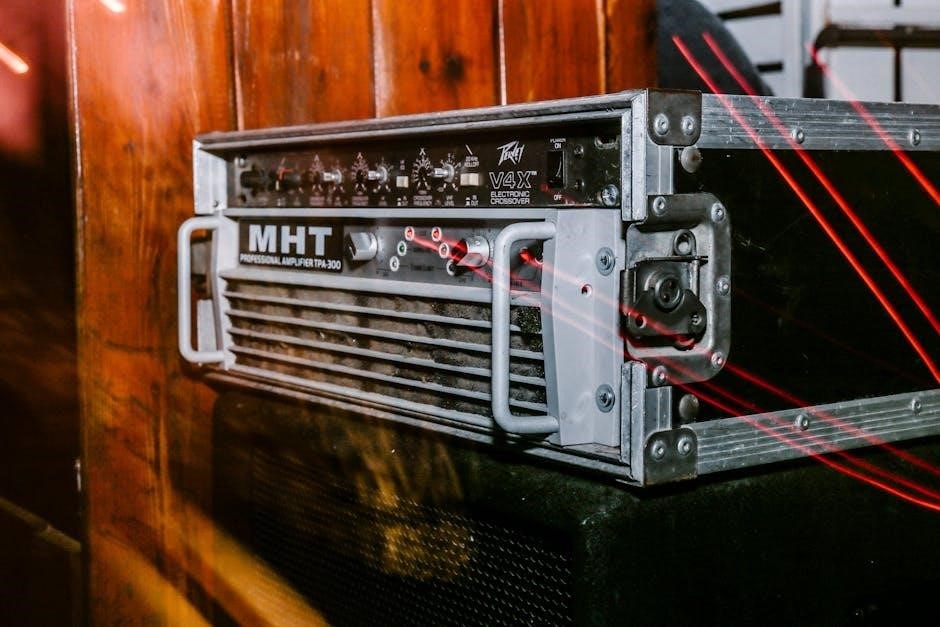
Tools and Materials Needed
Essential tools include wire strippers, cutters, and high-quality connectors. Use precise cutters to avoid damaging wires and ensure secure connections with proper terminals for optimal performance.
Wire Strippers and Cutters
Wire strippers and cutters are essential tools for preparing speaker wires. Strippers safely remove insulation without damaging the conductor, while cutters trim wires to the desired length. Choosing the right stripper is crucial, as improper use can nick or cut the wire, leading to signal loss. For thicker gauges (12-14 AWG), heavy-duty cutters are recommended. Automatic strippers are more efficient but costlier than manual ones. Always ensure compatibility with your wire gauge to avoid damage. Properly stripping and cutting wires ensures clean, secure connections, which are vital for maintaining sound quality and system performance.
Connectors and Terminals
Connectors and terminals are critical for securing speaker wire to amplifiers and speakers. Banana plugs, spade connectors, and pin connectors are common types, each offering unique installation benefits. Ensure compatibility with your equipment’s terminals to maintain a reliable connection. High-quality connectors made from materials like gold or nickel minimize corrosion and signal degradation. Properly attaching connectors to the wire is essential—soldering or crimping ensures a secure fit. Using the right terminal type for your gear (e.g., binding posts or spring clips) prevents signal loss. Poorly installed connectors can lead to interference or weak audio output, so precision is key for optimal performance.
Troubleshooting Common Issues
Troubleshooting common issues like signal loss, interference, and connection problems is essential for maintaining optimal audio quality. Diagnosing these problems often involves checking wire integrity and connections.
Diagnosing Signal Loss
Signal loss in speaker systems can be caused by various factors, including incorrect wire gauge, excessive wire length, or poor connections. To diagnose signal loss, start by inspecting the wire for damage or corrosion. Use a multimeter to measure resistance and ensure it matches the expected impedance. Check connections at both the amplifier and speaker ends for tightness and cleanliness. If signal loss persists, consider upgrading to a thicker gauge wire or shortening the wire run. Additionally, verify that the amplifier’s power output matches the speaker’s requirements to avoid underpowering, which can also lead to signal degradation.
Identifying and Fixing Interference
Interference in speaker systems can manifest as buzzing, static, or hum, often caused by electromagnetic interference (EMI) or radio-frequency interference (RFI). To identify the source, switch off nearby electronic devices and check if the noise persists. Use shielded speaker cables to minimize EMI. Ensure proper grounding of all components and avoid running speaker wires near power lines or transformers. If interference continues, installing ferrite chokes or noise filters on the wires can help. Upgrading to higher-quality cables or re-routing wires away from noise sources may also resolve the issue, ensuring cleaner audio transmission.
Selecting the right speaker wire gauge is vital for optimal sound quality. Proper wire thickness ensures minimal resistance and interference, delivering clear audio and reliable system performance.
Final Thoughts on Speaker Wire Selection
Choosing the right speaker wire gauge is essential for achieving optimal audio performance. Thicker wires (lower gauges) reduce resistance, ensuring clearer sound and better current flow, especially over longer distances. Always consider your system’s power requirements, speaker impedance, and the length of your runs when selecting a gauge. Properly matching the wire to your setup minimizes signal loss and interference, delivering high-quality audio. Additionally, prioritize safety by ensuring the wire can handle the maximum current and voltage your system requires. By carefully selecting the appropriate gauge, you can enjoy a reliable and immersive listening experience tailored to your audio needs.
